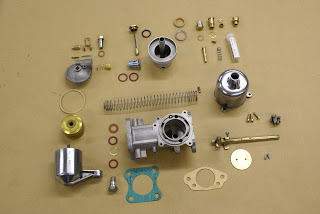Splitting the engine and gearbox after the trial fit, I notice that the assembly grease on the end of the gearbox main shaft is only displaced around 15mm. This explains why they supplied a new spigot bush (yet to be fitted) with the T5 box. Fellow XK enthusiast Tony Hamnet explains - the T5 main shaft is slightly shorter than the Moss item and is also moved back 10mm by the box to bell housing conversion plate. The new bush effectively extends the bearing surface forward by around 15mm.
 |
| New Spigot Bush extends bearing surface forwards around 15mm. |
Modifying the chassis to accept the T5 Gearbox
With the engine bottom half and gearbox now permanently together, I suspend them over the chassis with the front engine mounts vertically aligned in order to establish what needs to be done to accommodate the gearbox rear mounting pad.
 |
| Hate to change the chassis cross member but will no doubt consider it worthwhile when snicking through the T5 box next summer. |
 |
| Section cut out ready to take new metal. I really must give those shoes a polish. |
Apologies for the measurement mixture but as an imperial boy and a metric man it works for me.
 |
| Simple to make but very strong - filler and support |
 |
| I can't believe this is a casting error so can someone tell me why the mounting plate is around 10 degrees from horizontal? |
 |
| Bobbins set to allow for angle with tapered washers. Note essential extra long threads on bobbins to clear 15mm thick mounting. |
 |
| Neatly welded in place (not by me!) with 2mm plate filling in the sides. Fine texture stone-guard and two pack satin finish all made good. |
 |
| Finally in place. Output shaft centre is 2" above top of cross member as per original moss box . |
Classics on show Stokesley - June 16th
My home town held its first Classic Car Show on Saturday 16th June, organised by the local Rotarians. In spite of a rather poor weather forecast, a turnout of over 100 classics enjoyed an extremely good atmosphere with many old friends meeting up and enjoying the day.
 |
| A corner of the large show ground swallows up the 100 plus classics turning up to the very first Stokesley "Classics on Show" England's Green and Pleasant Land at its best. |
Just a matter of time I think, before the list of world class venues reads - Pebble Beach, Carmel, Amelia Island, Stokesley, Villa d'Este, Salon Prive'.
Congratulations and thanks to the organisers for a very enjoyable day.
Beamish Run - June 17th
'The Beamish' as it is generally known, is a 144 mile County Durham based reliability trial for vehicles manufactured before the end of 1955 (very strict). My 140 fixed head just qualifies and is possibly the youngest of the 160 cars participating this year. Early car manufacturers used a number of notably difficult routes, with streams to ford, long and steep gradients to ascend / descend, often with very sharp bends. The Beamish Connects many of these trial routes together and makes for an exhilarating full days rally. In addition to completing the course, points are also scored by answering a series of often eclectic motor related questions at each check point. A superb day out in some of England's most beautiful countryside and loads of fun.
 |
| End of day. XK140 and super rare Swallow Dorreti. Note standard British Post War Male hands in pockets stance. |
 |
| XK120 came all the way from the Isle of Man |
 |
| Grandsons "Chicken Pox Charlie" (left) and "The Fredster" help with the Monday morning clean up. |
 |
| Thanks Uncle Dan http://www.classicjaguar.com/ |










